|
|
|

|
|
 Surface-enhanced Raman scattering on silvered porous alumina templates: role of multipolar surface plasmon resonant modes
Surface-enhanced Raman scattering on silvered porous alumina templates: role of multipolar surface plasmon resonant modes
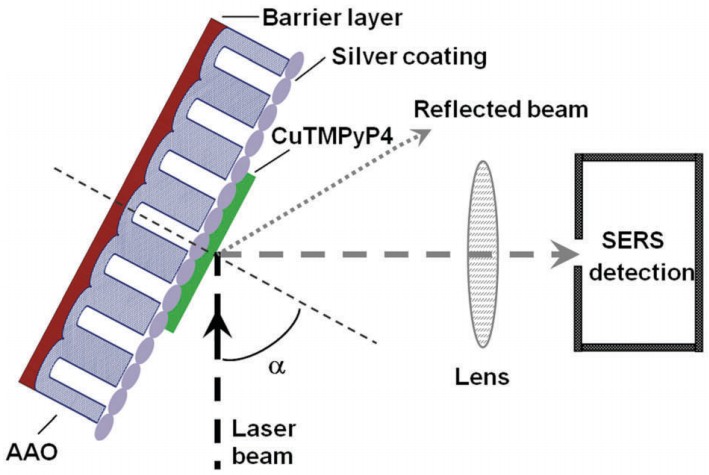 Nanostructured silver films with different thicknesses were prepared by vapor deposition onto the surface of the anodic aluminum oxide (AAO) template to be used as surface-enhanced Raman scattering (SERS) active substrates. Both the peak position of the surface plasmon resonance (SPR) band and SERS enhancement of silvered AAO samples displayed non-monotonous dependence on Ag layer thickness. Using 441.6 nm excitation and a water-soluble cationic porphyrin, Cu(II)-tetrakis (4-N-methylpyridyl) (CuTMPyP4), as a SERS-reporting analyte, two maxima of the SERS enhancement were obtained for Ag layers of 15 and 120 nm thickness. Thickness dependencies have been analyzed taking into account the type of SPR modes identified by means of quasicrystalline approximation (QCA) of statistical theory of multiple scattering of waves and multi-Lorentzian deconvolution. The analysis revealed that SERS enhancement is related to the absolute magnitude of the distance between excitation wavelength and spectral position of collective SPR mode. It was shown that matching of excitation wavelength and the most intensive SPR modes with non-radiative decay, generated mainly by coherent interaction of higher-order plasmon resonant modes (quadrupole and octupole), plays a dominate role in SERS performance. Besides, it has been observed that more intense SERS signal can be obtained when the analyte deposited on the Ag/AAO substrate was excited through the AAO template rather than from the silvered side. Our results demonstrate that appropriate excitation geometry and fine-tuning of the optical properties of the Ag/AAO substrate by adjusting the thickness of the Ag layer with respect to particular excitation wavelength can contribute to more effective SERS enhancement.
Phys. Chem. Chem. Phys., Oct 2015.
Nanostructured silver films with different thicknesses were prepared by vapor deposition onto the surface of the anodic aluminum oxide (AAO) template to be used as surface-enhanced Raman scattering (SERS) active substrates. Both the peak position of the surface plasmon resonance (SPR) band and SERS enhancement of silvered AAO samples displayed non-monotonous dependence on Ag layer thickness. Using 441.6 nm excitation and a water-soluble cationic porphyrin, Cu(II)-tetrakis (4-N-methylpyridyl) (CuTMPyP4), as a SERS-reporting analyte, two maxima of the SERS enhancement were obtained for Ag layers of 15 and 120 nm thickness. Thickness dependencies have been analyzed taking into account the type of SPR modes identified by means of quasicrystalline approximation (QCA) of statistical theory of multiple scattering of waves and multi-Lorentzian deconvolution. The analysis revealed that SERS enhancement is related to the absolute magnitude of the distance between excitation wavelength and spectral position of collective SPR mode. It was shown that matching of excitation wavelength and the most intensive SPR modes with non-radiative decay, generated mainly by coherent interaction of higher-order plasmon resonant modes (quadrupole and octupole), plays a dominate role in SERS performance. Besides, it has been observed that more intense SERS signal can be obtained when the analyte deposited on the Ag/AAO substrate was excited through the AAO template rather than from the silvered side. Our results demonstrate that appropriate excitation geometry and fine-tuning of the optical properties of the Ag/AAO substrate by adjusting the thickness of the Ag layer with respect to particular excitation wavelength can contribute to more effective SERS enhancement.
Phys. Chem. Chem. Phys., Oct 2015.
|
 Effective optical constants of composite materials with an arbitrary volume concentration of nanoinclusions
Effective optical constants of composite materials with an arbitrary volume concentration of nanoinclusions
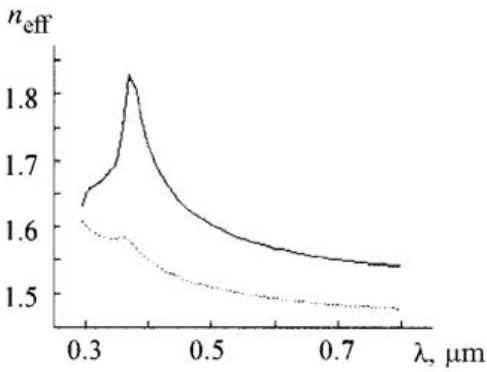 A new mixing rule for the effective dielectric constant of composite materials is formulated on the basis of a probabilistic approach for describing the structure of granular composite structures. The advantages of the proposed model become apparent for high concentrations of inclusions with optical constants that differ sig-nificantly from those of the matrix. The distinctive feature of this model compared to the Maxwell Garnett rule is symmetry of the computational formulas and their invariance with respect to the numbering order of the materials, as well as the possibility of describing the two-mode structure of the surface plasmon resonance absorption band in metal-dielectric nanocomposites with a high concentration of the metallic phase.
J. Appl. Spectr., Nov 2012.
A new mixing rule for the effective dielectric constant of composite materials is formulated on the basis of a probabilistic approach for describing the structure of granular composite structures. The advantages of the proposed model become apparent for high concentrations of inclusions with optical constants that differ sig-nificantly from those of the matrix. The distinctive feature of this model compared to the Maxwell Garnett rule is symmetry of the computational formulas and their invariance with respect to the numbering order of the materials, as well as the possibility of describing the two-mode structure of the surface plasmon resonance absorption band in metal-dielectric nanocomposites with a high concentration of the metallic phase.
J. Appl. Spectr., Nov 2012.
|
 Plasmonic spectroscopy of 2D densely packed and layered metallic nanostructures
Plasmonic spectroscopy of 2D densely packed and layered metallic nanostructures
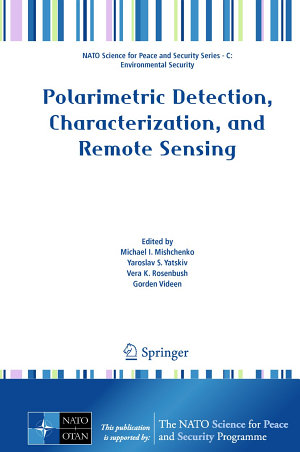 This chapter is an overview of size and concentration effects on electrodynamic coupling in two-dimensional densely packed arrays of metallic nano-spheres in the frequency range of the surface plasmon resonance (SPR). Our theoretical analysis is based on the statistical theory of multiple scattering of waves. We show that concentration effects, such as the enhanced long-wavelength transmission of light and the strong resonance quenching of transmission, are effectively interpreted in terms of constructive and destructive interference of waves incident on and scattered by a monolayer of closely-packed submicrometer plasmonic particles. The concentration SPR red shift observed in the case of dipole metal nanoparticles is highly sensitive to the matrix refractive index and results from lateral near-field couplings. We also demonstrate phenomena caused by a strong plasmonic–photonic confinement in multilayered metal–dielectric nanostructures consisting of densely packed monolayers. For example, we show that employing the size and/or concentration gradient of dipole metallic nanoparticles in a quarter-wavelength multilayered system allows one to achieve an almost total absorbance.
Chapter in Springer Book (2011).
This chapter is an overview of size and concentration effects on electrodynamic coupling in two-dimensional densely packed arrays of metallic nano-spheres in the frequency range of the surface plasmon resonance (SPR). Our theoretical analysis is based on the statistical theory of multiple scattering of waves. We show that concentration effects, such as the enhanced long-wavelength transmission of light and the strong resonance quenching of transmission, are effectively interpreted in terms of constructive and destructive interference of waves incident on and scattered by a monolayer of closely-packed submicrometer plasmonic particles. The concentration SPR red shift observed in the case of dipole metal nanoparticles is highly sensitive to the matrix refractive index and results from lateral near-field couplings. We also demonstrate phenomena caused by a strong plasmonic–photonic confinement in multilayered metal–dielectric nanostructures consisting of densely packed monolayers. For example, we show that employing the size and/or concentration gradient of dipole metallic nanoparticles in a quarter-wavelength multilayered system allows one to achieve an almost total absorbance.
Chapter in Springer Book (2011).
|
 A comparative study of surface-enhanced Raman scattering from silver-coated anodic aluminum oxide and porous silicon
A comparative study of surface-enhanced Raman scattering from silver-coated anodic aluminum oxide and porous silicon
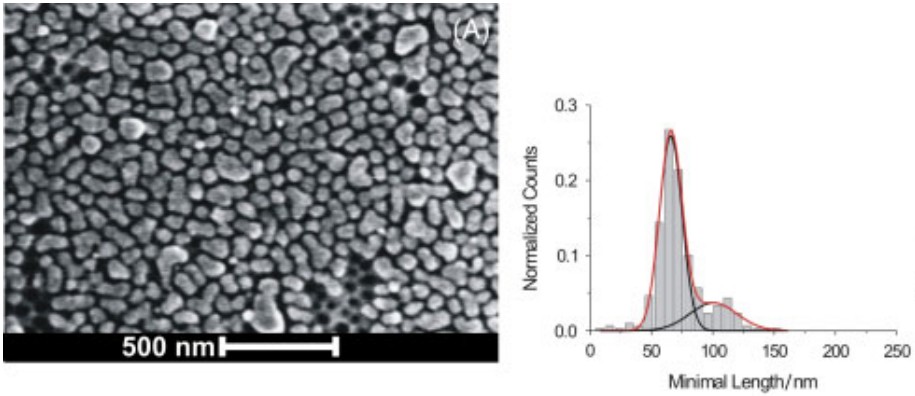 Three types of Ag-coated arrays from porous anodic aluminum oxide (AAO) were prepared and studied as substrates for surface-enhanced Raman scattering (SERS). They were compared with Ag-coated porous silicon (PSi) samples. AAO-based substrates were prepared by the vapor deposition of silver directly onto the surface of porous AAO with different morphologies of the pores, whereas SERS-active island films on the PSi were prepared by immersion plating. The resulting metallic nanostructures were characterized by UV-vis absorption spectroscopy and scanning electron microscopy (SEM). Thermal evaporation leads to the formation of granular arrays of Ag nanoparticles on the surface of AAO. SERS activity of the substrates was tested using
water-soluble cationic Zn(II)-tetrakis (4-N-methylpyridyl) porphyrin (ZnTMPyP4) as a probe molecule. The results indicate that all AAO-based substrates studied here exhibit some degree of SERS activity. Noteworthy, for excitation at 532 nm, signals from AAO-based substrates were comparable with those from the PSi-based ones, whereas for 441.6 nm excitation they were about twice higher. The strongest SERS-enhancement at 441.6 nm excitation was provided by the AAO substrates with silver deposited on the monolith (originally nonporous) side of AAO. Preferential SERS-enhancement of the bands ascribed to the vibrations of the N-methylpyridinium group of ZnTMPyP4 when going to blue excitation was found.
J. Raman Spectrosc., Jan 2011.
Three types of Ag-coated arrays from porous anodic aluminum oxide (AAO) were prepared and studied as substrates for surface-enhanced Raman scattering (SERS). They were compared with Ag-coated porous silicon (PSi) samples. AAO-based substrates were prepared by the vapor deposition of silver directly onto the surface of porous AAO with different morphologies of the pores, whereas SERS-active island films on the PSi were prepared by immersion plating. The resulting metallic nanostructures were characterized by UV-vis absorption spectroscopy and scanning electron microscopy (SEM). Thermal evaporation leads to the formation of granular arrays of Ag nanoparticles on the surface of AAO. SERS activity of the substrates was tested using
water-soluble cationic Zn(II)-tetrakis (4-N-methylpyridyl) porphyrin (ZnTMPyP4) as a probe molecule. The results indicate that all AAO-based substrates studied here exhibit some degree of SERS activity. Noteworthy, for excitation at 532 nm, signals from AAO-based substrates were comparable with those from the PSi-based ones, whereas for 441.6 nm excitation they were about twice higher. The strongest SERS-enhancement at 441.6 nm excitation was provided by the AAO substrates with silver deposited on the monolith (originally nonporous) side of AAO. Preferential SERS-enhancement of the bands ascribed to the vibrations of the N-methylpyridinium group of ZnTMPyP4 when going to blue excitation was found.
J. Raman Spectrosc., Jan 2011.
|
 Plasmon coupling in two-dimensional arrays of silver nanoparticles: I. Effect of the dielectric medium
Plasmon coupling in two-dimensional arrays of silver nanoparticles: I. Effect of the dielectric medium
 The effect of the dielectric medium between the particles on plasmon coupling was studied experimentally and theoretically. Two-dimensional arrays of silver nanoparticles adsorbed on glass slides were immobilized using poly(methylmethacrylate). The method provides an efficient way for stabilization of particles on surfaces. It was concluded that increasing the dielectric function of the surrounding medium promotes plasmon coupling between silver nanoparticles. On the basis of the quasi-crystalline approximation, the optimum refractive index was calculated that yielded the strongest and highest Q extinction band due to coherent plasmon coupling.
J. Phys. Chem. C, Apr 2009.
The effect of the dielectric medium between the particles on plasmon coupling was studied experimentally and theoretically. Two-dimensional arrays of silver nanoparticles adsorbed on glass slides were immobilized using poly(methylmethacrylate). The method provides an efficient way for stabilization of particles on surfaces. It was concluded that increasing the dielectric function of the surrounding medium promotes plasmon coupling between silver nanoparticles. On the basis of the quasi-crystalline approximation, the optimum refractive index was calculated that yielded the strongest and highest Q extinction band due to coherent plasmon coupling.
J. Phys. Chem. C, Apr 2009.
|
 Total light absorption in ultrathin size-gradient metal-dielectric nanostructures
Total light absorption in ultrathin size-gradient metal-dielectric nanostructures
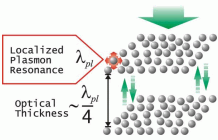 We propose ultrathin plasmonic nanocoatings that can absorb more than 90% of visible light in a broad (exceeding 100 nm) wavelength range, reaching almost total absorption at the surface plasmon resonance (SPR) wavelength. Such a coating contains only two monolayers of metal nanoparticles (with smaller nanoparticles in the first monolayer and larger nanoparticles in the second monolayer) separated by a dielectric film with quarter-wave thickness. We analytically derive spectral characteristics of two-monolayer systems and explore the regimes, which must be satisfied for realization of high-absorptive coatings at the SPR range.
Proc. of SPIE, 2007.
We propose ultrathin plasmonic nanocoatings that can absorb more than 90% of visible light in a broad (exceeding 100 nm) wavelength range, reaching almost total absorption at the surface plasmon resonance (SPR) wavelength. Such a coating contains only two monolayers of metal nanoparticles (with smaller nanoparticles in the first monolayer and larger nanoparticles in the second monolayer) separated by a dielectric film with quarter-wave thickness. We analytically derive spectral characteristics of two-monolayer systems and explore the regimes, which must be satisfied for realization of high-absorptive coatings at the SPR range.
Proc. of SPIE, 2007.
|
 High-absorbing gradient multilayer coatings with silver nanoparticles
High-absorbing gradient multilayer coatings with silver nanoparticles
 We suggest an efficient way to enhance broadband visible light absorption in multilayer nanostructured systems formed by silver nanoparticle arrays. This approach is based on the explicit use of a gradient change in the parameters of the arrays (such as nanoparticle size or concentration). We analytically derive general conditions of the spectral characteristics of individual arrays which must be satisfied for the realization of highly-absorptive gradient multilayer nanostructured coatings. Two specific types of gradient coatings, (i) with the gradient of the size of the silver nanoparticles in the arrays and (ii) with the gradient of their surface concentration, are numerically studied in detail. The obvious advantages of the size-gradient coatings are revealed, in particular their total thickness of less than a wavelength. Multilayer coatings with a concurrent gradient of both concentration and mean particle size are fabricated from silver island films and their high and broadband absorption is demonstrated experimentally.
Appl. Phys. B, Jul 2006.
We suggest an efficient way to enhance broadband visible light absorption in multilayer nanostructured systems formed by silver nanoparticle arrays. This approach is based on the explicit use of a gradient change in the parameters of the arrays (such as nanoparticle size or concentration). We analytically derive general conditions of the spectral characteristics of individual arrays which must be satisfied for the realization of highly-absorptive gradient multilayer nanostructured coatings. Two specific types of gradient coatings, (i) with the gradient of the size of the silver nanoparticles in the arrays and (ii) with the gradient of their surface concentration, are numerically studied in detail. The obvious advantages of the size-gradient coatings are revealed, in particular their total thickness of less than a wavelength. Multilayer coatings with a concurrent gradient of both concentration and mean particle size are fabricated from silver island films and their high and broadband absorption is demonstrated experimentally.
Appl. Phys. B, Jul 2006.
|
|
|
|

